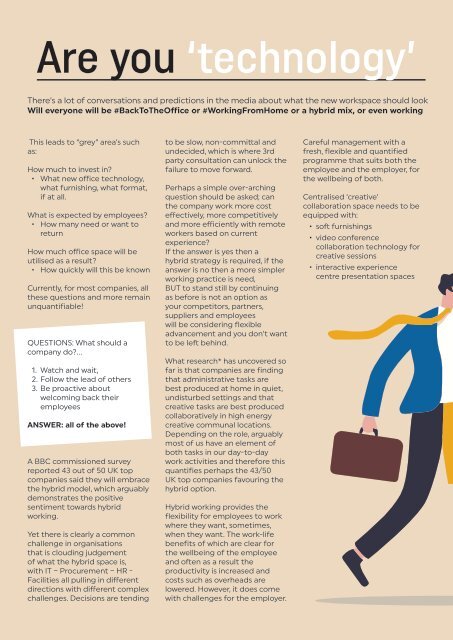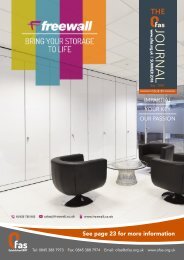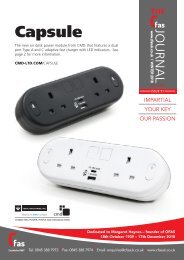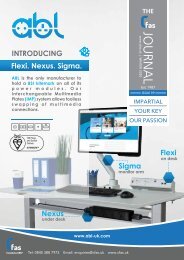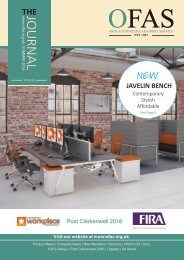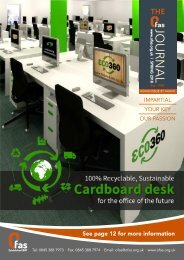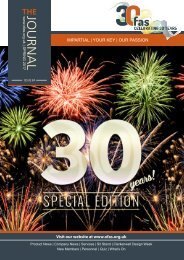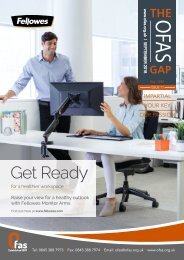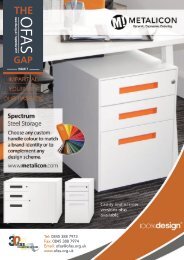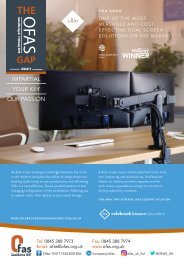CFAS Autumn 2021 Journal
Create successful ePaper yourself
Turn your PDF publications into a flip-book with our unique Google optimized e-Paper software.
Industry News and Services<br />
Are you ‘technology’<br />
There’s a lot of conversations and predictions in the media about what the new workspace should look<br />
Will everyone will be #BackToTheOffice or #WorkingFromHome or a hybrid mix, or even working<br />
This leads to “grey” area’s such<br />
as:<br />
How much to invest in?<br />
• What new office technology,<br />
what furnishing, what format,<br />
if at all.<br />
What is expected by employees?<br />
• How many need or want to<br />
return<br />
How much office space will be<br />
utilised as a result?<br />
• How quickly will this be known<br />
Currently, for most companies, all<br />
these questions and more remain<br />
unquantifiable!<br />
QUESTIONS: What should a<br />
company do?…<br />
1. Watch and wait,<br />
2. Follow the lead of others<br />
3. Be proactive about<br />
welcoming back their<br />
employees<br />
ANSWER: all of the above!<br />
A BBC commissioned survey<br />
reported 43 out of 50 UK top<br />
companies said they will embrace<br />
the hybrid model, which arguably<br />
demonstrates the positive<br />
sentiment towards hybrid<br />
working.<br />
Yet there is clearly a common<br />
challenge in organisations<br />
that is clouding judgement<br />
of what the hybrid space is,<br />
with IT – Procurement – HR -<br />
Facilities all pulling in different<br />
directions with different complex<br />
challenges. Decisions are tending<br />
to be slow, non-committal and<br />
undecided, which is where 3rd<br />
party consultation can unlock the<br />
failure to move forward.<br />
Perhaps a simple over-arching<br />
question should be asked; can<br />
the company work more cost<br />
effectively, more competitively<br />
and more efficiently with remote<br />
workers based on current<br />
experience?<br />
If the answer is yes then a<br />
hybrid strategy is required, if the<br />
answer is no then a more simpler<br />
working practice is need,<br />
BUT to stand still by continuing<br />
as before is not an option as<br />
your competitors, partners,<br />
suppliers and employees<br />
will be considering flexible<br />
advancement and you don’t want<br />
to be left behind.<br />
What research* has uncovered so<br />
far is that companies are finding<br />
that administrative tasks are<br />
best produced at home in quiet,<br />
undisturbed settings and that<br />
creative tasks are best produced<br />
collaboratively in high energy<br />
creative communal locations.<br />
Depending on the role, arguably<br />
most of us have an element of<br />
both tasks in our day-to-day<br />
work activities and therefore this<br />
quantifies perhaps the 43/50<br />
UK top companies favouring the<br />
hybrid option.<br />
Hybrid working provides the<br />
flexibility for employees to work<br />
where they want, sometimes,<br />
when they want. The work-life<br />
benefits of which are clear for<br />
the wellbeing of the employee<br />
and often as a result the<br />
productivity is increased and<br />
costs such as overheads are<br />
lowered. However, it does come<br />
with challenges for the employer.<br />
Careful management with a<br />
fresh, flexible and quantified<br />
programme that suits both the<br />
employee and the employer, for<br />
the wellbeing of both.<br />
Centralised ‘creative’<br />
collaboration space needs to be<br />
equipped with:<br />
• soft furnishings<br />
• video conference<br />
collaboration technology for<br />
creative sessions<br />
• interactive experience<br />
centre presentation spaces<br />
14 | www.cfas.uk


